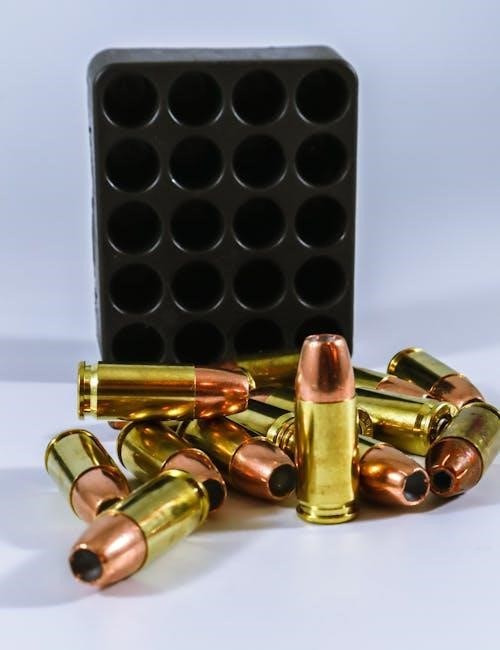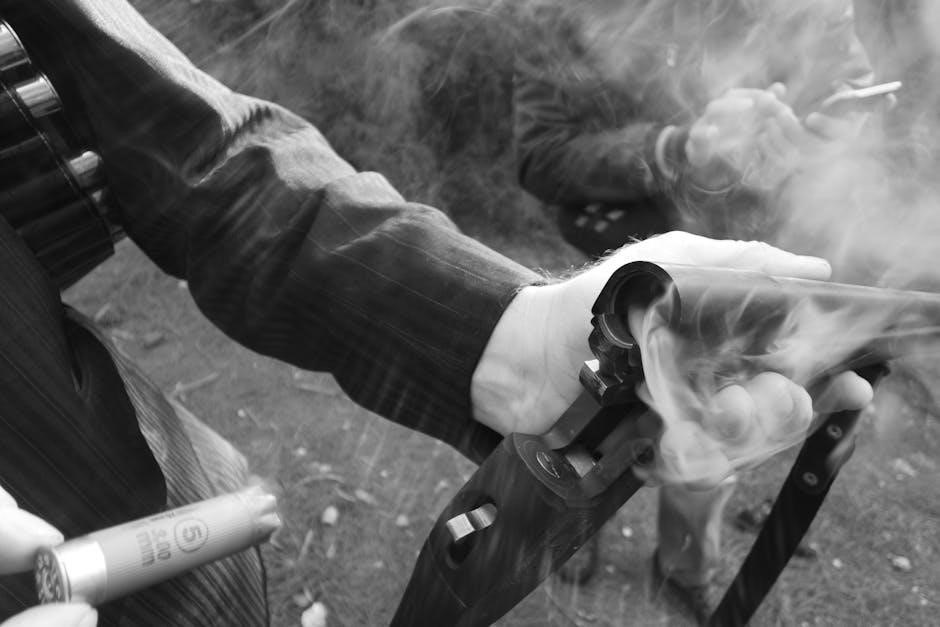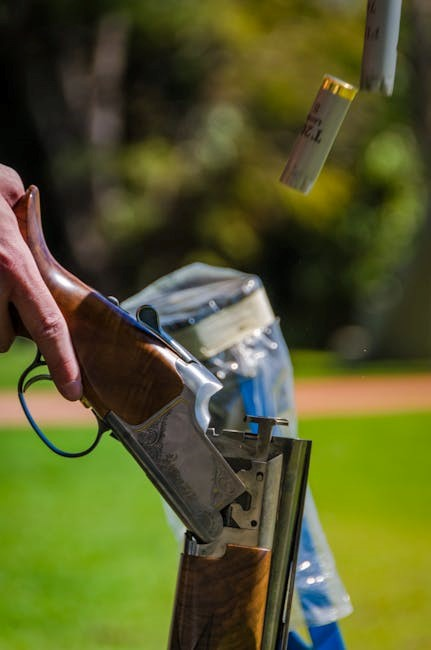
Welcome to the world of shotgun reloading! This manual serves as your guide to safely and effectively creating reliable shotshells. Whether you’re a novice or an experienced reloader, this comprehensive resource covers essential techniques, safety protocols, and troubleshooting tips to ensure successful reloading. Discover how to produce consistent, high-performance shotshells with detailed data and expert advice.
1.1 Overview of Shotgun Reloading
Shotgun reloading involves preparing and assembling shotgun shells to meet specific performance needs. This process includes selecting hulls, primers, wads, shot, and powder, ensuring compatibility and safety. Reloaders can customize loads for hunting, target shooting, or home defense, achieving consistent results. With proper tools and data, reloading saves money and allows shooters to tailor ammunition to their preferences, enhancing accuracy and reliability. It requires attention to detail and adherence to safety guidelines for optimal performance.
1.2 Importance of Using a Reliable Manual
A reliable manual is crucial for safe and successful shotgun reloading. It provides detailed load data, safety guidelines, and step-by-step instructions, ensuring consistency and accuracy. Manuals like the Lyman Shotshell Reloading Handbook offer comprehensive information on hulls, primers, wads, and powders, helping reloaders avoid errors. They also include expert tips and troubleshooting advice, making them indispensable for achieving optimal results and maintaining safety standards in the reloading process.
Safety Measures in Shotgun Reloading
Safety is paramount in shotgun reloading. Always wear protective gear, ensure proper ventilation, and follow established guidelines to prevent accidents. Adhering to safety protocols ensures a secure reloading environment and prevents potential hazards.
2.1 Essential Safety Practices
Always wear safety glasses and gloves when reloading. Ensure proper ventilation to avoid inhaling powder or primer fumes. Use a reliable manual and follow load data precisely. Keep the workspace clean and free from distractions. Never deviate from recommended procedures. Maintain equipment in good condition and avoid overloading shells. Store components separately and follow manufacturer guidelines. Always double-check loads before assembly to prevent accidents and ensure safe reloading practices.
- Wear protective gear consistently.
- Follow load data accurately.
- Keep the area well-ventilated.
- Avoid distractions while reloading.
2.2 Understanding Safety Precautions
Understanding safety precautions is critical for avoiding accidents in shotgun reloading. Always follow load data from trusted manuals to prevent overloading, which can lead to dangerous pressure levels. Proper ventilation is essential to avoid inhaling hazardous fumes from primers and powder. Keep reloading areas clean and organized to minimize risks. Familiarize yourself with equipment operation and never reload in a hurry. Double-check loads before assembly to ensure safety and reliability.

Tools and Equipment Needed
Essential tools include a shotshell press, reloading dies, and a powder scale. Quality manuals like Lyman Shotshell provide detailed load data for consistency. Use RCBS presses for precision and reliability in producing accurate, high-performance shotshells.
3.1 Basic Reloading Tools
The essential tools for shotgun reloading include a shotshell press, reloading dies, and a powder scale. A hull cutter is necessary for resizing and preparing cases. Safety glasses and a reloading manual like the Lyman Shotshell Handbook are crucial for guidance. These tools ensure precision and safety, helping you achieve consistent results in producing high-quality shotshells.
3.2 Essential Equipment for Consistent Results
For consistent shotgun reloading, essential equipment includes a precision powder scale, digital calipers, and a shotshell press with interchangeable dies. A hull trimmer ensures uniform case lengths, while a wad guide aligns components accurately. A reloading manual like the Lyman Shotshell Handbook provides critical load data. These tools, along with a clean workspace, are vital for maintaining consistency and producing reliable shotshells.

Components of Shotgun Shells
Shotgun shells consist of a hull, primer, powder, wad, and shot. These components work together to ensure reliable ignition, consistent performance, and accurate shot distribution.
4.1 Understanding Hulls, Wads, and Primers
The hull is the shotgun shell’s outer casing, available in various lengths and gauges. Wads, made of plastic, separate the powder from the shot and ensure proper patterning. Primers ignite the powder charge, ensuring reliable combustion. Each component plays a critical role in performance and safety. Understanding their materials, sizes, and functions is essential for successful reloading and consistent shotshell performance.
4.2 Role of Powder in Reloading
Powder serves as the energy source, propelling the shot down the barrel. Available in smokeless and other forms, its burn rate and density impact performance. Proper powder selection ensures optimal velocity and consistent patterns. Manuals provide detailed data to help reloaders choose the best options for their loads, ensuring safety and effectiveness in shotshell reloading.

Step-by-Step Reloading Process
This section guides you through the step-by-step process of reloading shotgun shells, from inspecting hulls to final crimping, ensuring precision and safety in each step.
5.1 Inspecting and Preparing Hulls
Inspecting and preparing hulls is the first critical step in shotgun reloading. Examine each hull for cracks, splits, or damage. Clean and dry hulls thoroughly to ensure proper resizing and crimping. Remove any old residue or debris. Check for worn or damaged brass bases and discard any unfit hulls. Proper preparation ensures reliable performance and safety in your reloaded shotshells. This step is essential for achieving consistent results.
5.2 Assembling the Shell
Assembling the shell involves carefully combining the hull, primer, wad, powder, and shot. Start by installing the primer and wad, ensuring proper alignment. Measure and pour the powder, then add the shot. Seat the wad firmly and crimp the shell to secure all components. Use a reloading press for consistency and reliability. Always follow load data from a trusted manual to achieve optimal performance and safety in your reloaded shotshells.
Troubleshooting Common Issues
Identify and resolve issues like inconsistent patterns, misfires, or over-pressure by checking powder charges, primer seating, and crimp quality. Consult manuals for solutions and adjustments.
6.1 Identifying and Solving Reloading Problems
Common issues in shotgun reloading include misfires, inconsistent patterns, or over-pressure. Inspect hulls, primers, and powder charges for defects or incorrect measurements. Ensure proper wad alignment and crimp quality. Consult your manual for troubleshooting guides and adjust loads as needed. Keep detailed records to trace and resolve errors. Always follow safety protocols and seek expert advice if problems persist.
6.2 Tips for Avoiding Mistakes
To avoid errors, always follow established reloading procedures and use a reliable manual. Double-check powder measurements and ensure hulls are clean and undamaged. Properly align wads and maintain consistent crimp pressure. Avoid distractions and work in a well-lit, organized space. Keep detailed records of your loads for future reference. Regularly inspect tools and equipment for wear. By adhering to these practices, you can minimize mistakes and ensure safe, reliable shotshell reloading.

Advanced Reloading Techniques
Explore advanced methods for customizing loads, optimizing performance, and achieving precision in shotgun reloading. Learn expert techniques for creating specialized shotshells tailored to specific shooting needs.
7.1 Customizing Loads for Specific Needs
Customizing shotgun loads allows shooters to tailor performance for specific applications, such as hunting, target shooting, or home defense. By adjusting components like hulls, wads, powders, and shot types, reloaders can optimize patterns, velocity, and payload delivery. Advanced techniques include using non-toxic shot for environmental considerations or experimenting with specialized wads for tighter spreads. Detailed load data in manuals like the Lyman Shotshell Reloading Handbook provides guidance for creating customized, high-performance shotshells.
7.2 Optimizing Performance
Optimizing shotgun shell performance involves refining load recipes to achieve consistent patterns, accurate velocities, and reliable ignition. Adjusting powder charges, shot sizes, and wad types can significantly enhance performance. Advanced techniques include testing different burn rates and ensuring proper hull fit. Comprehensive load data in manuals like the Lyman Shotshell Reloading Handbook provides detailed insights for maximizing efficiency. Fine-tuning your loads ensures superior accuracy and power for any shooting application.
Load Data and Tables
Comprehensive load data and tables provide essential information for safe and effective shotgun reloading. Detailed charts outline powder charges, shot weights, and velocities for various hulls and wads.
8.1 Using Load Data Effectively
Load data is crucial for safe and consistent shotgun reloading. Always reference reputable manuals like the Lyman Shotshell Reloading Handbook for precise powder charges, shot weights, and velocities. Understand the tables to ensure compatibility with your hulls, wads, and primers. Cross-reference data to avoid overload risks and verify manufacturer guidelines. Accurate interpretation of load data guarantees reliable performance and safety in your reloaded shotshells.
8.2 Reference Tables for Safe Reloading
Reference tables are essential for safe shotgun reloading, providing detailed data on powder charges, shot weights, and velocities. These tables, often found in manuals like the Lyman Shotshell Handbook, ensure compatibility between hulls, wads, and primers. They help prevent overload risks and guide reloaders in selecting safe, efficient combinations. Use these tables to verify manufacturer recommendations and achieve consistent, reliable results in your reloading process.
Non-Toxic and Specialty Shotshells
Non-toxic shotshells, such as steel, bismuth, and Hevi-Shot, are ideal for environmentally friendly reloading. Specialty shells cater to specific needs like reduced recoil or enhanced performance for hunting or competition.
9.1 Reloading for Environmental Considerations
Reloading non-toxic shotshells is crucial for environmental conservation. Using materials like steel, bismuth, or Hevi-Shot reduces lead contamination. These options are ideal for hunting in restricted areas. Detailed data in manuals ensures safe and effective reloading of eco-friendly loads, promoting sustainable shooting practices while maintaining performance. This approach supports wildlife protection and complies with regulations, making it a responsible choice for modern reloaders.
9.2 Specialized Shotshell Options
Specialized shotshell options cater to specific shooting needs, offering enhanced performance and versatility. Reloaders can choose from steel, bismuth, or Hevi-Shot for non-toxic requirements, while buffered shots improve patterning. The manual provides detailed load data for these specialized shells, ensuring optimal results in various shooting scenarios. This flexibility allows reloaders to customize loads for hunting, competition, or personal preference, making shotshell reloading highly adaptable to individual demands.
Shotgun reloading offers a rewarding way to customize loads for specific needs. By following safety guidelines and best practices, reloaders can achieve consistent, high-performance results. This manual provides the knowledge to maximize efficiency and precision, ensuring successful reloading experiences for both novices and experienced shooters alike. Safe reloading practices lead to optimal shotshell performance and lasting satisfaction.
10.1 Final Tips for Successful Reloading
Always double-check load data and ensure consistency in your process. Maintain clean equipment and store components properly. Start with small batches to verify performance. Keep detailed records of your loads for future reference. Stay updated with the latest manual revisions and safety guidelines. Practice patience and attention to detail to achieve reliable, high-quality shotshells. Safe reloading practices and adherence to proven techniques will maximize your results and satisfaction.